Abstract
The neurosecretory caudodorsal cells of the freshwater pulmonate snail Lymnaea stagnalis produce an ovulation hormone [caudodorsal cell hormone (CDCH)] that is stored and released at the periphery of the intercerebral commissure. In the present study, CDCH has been purified and sequenced by micromethods. CDCH has been isolated, starting with a hydrochloric acid extract of commissures, by chromatofocusing, by high-performance, gel-permeation chromatography, and by reversed-phase, high-performance liquid chromatography. This procedure resulted in a 1690-fold purification and a 66% recovery. The data of the sequence analysis of CDCH are in agreement with the amino acid composition and reveal the following sequence of 36 amino acids: H-Leu-Ser-Ile-Thr-Asn-Asp-Leu-Arg-Ala-Ile-Ala-Asp-Ser-Tyr-Leu-Tyr-Asp-Gln-His -Trp-Leu-Arg-Glu-Arg-Gln-Glu-Glu-Asn-Leu-Arg-Arg-Arg-Phe-Leu-Glu-Leu-OH. Enzyme data indicate that the COOH end of the hormone is amidated. CDCH has a calculated isoelectric point of 9.0 and a calculated Mr of 4529. CDCH shares a 44% homology with the sequence of the egg-laying hormone of the marine opisthobranch mollusc Aplysia californica.
Keywords: high-performance liquid chromatography, molluscan neurohormone, primary structure, microsequence analysis
Full text
PDF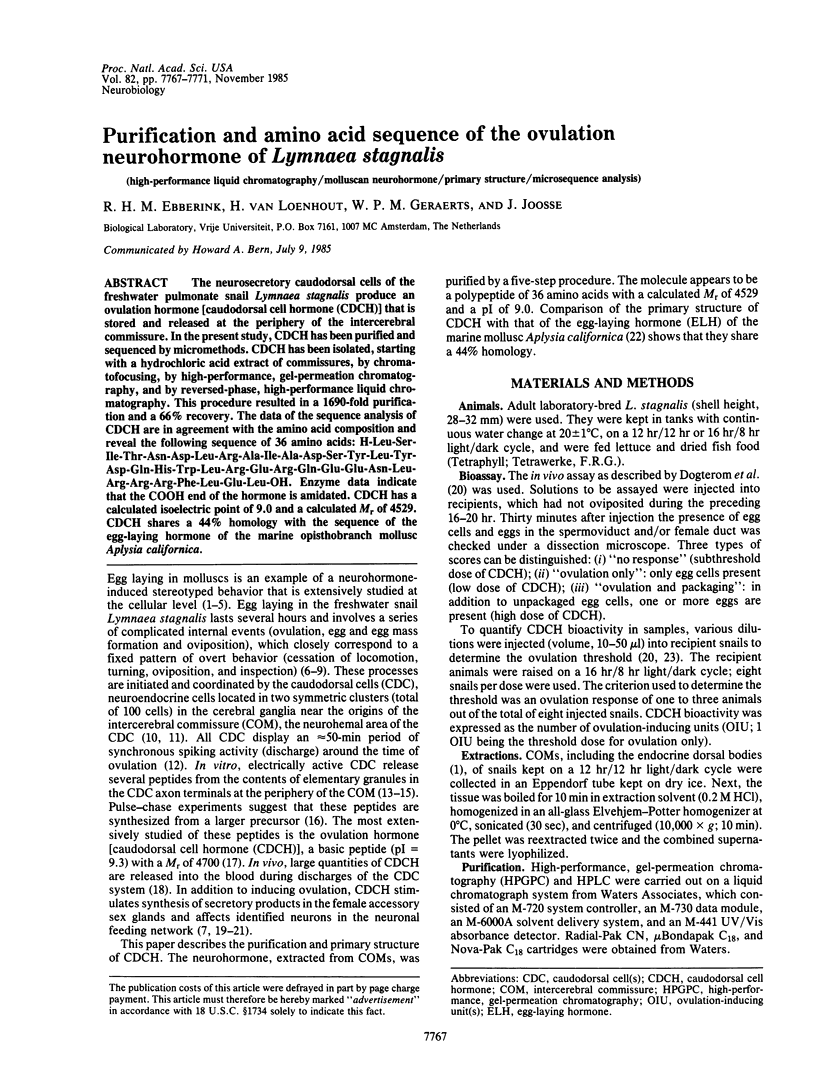
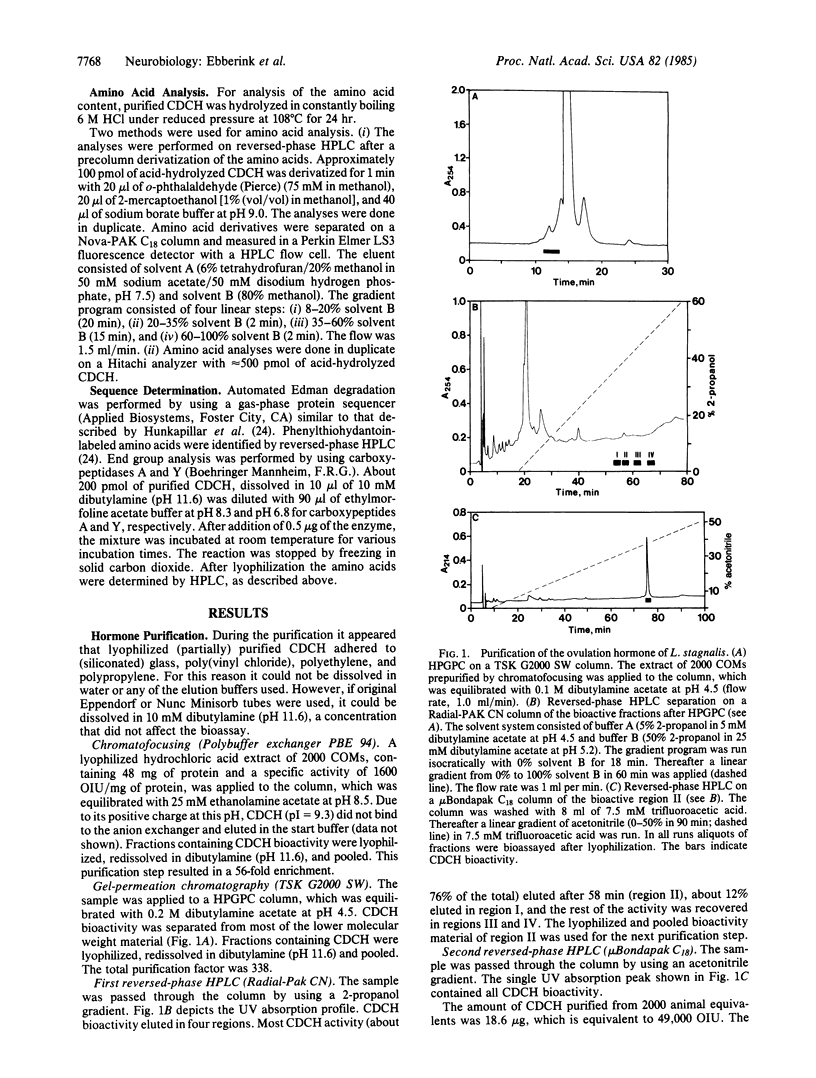
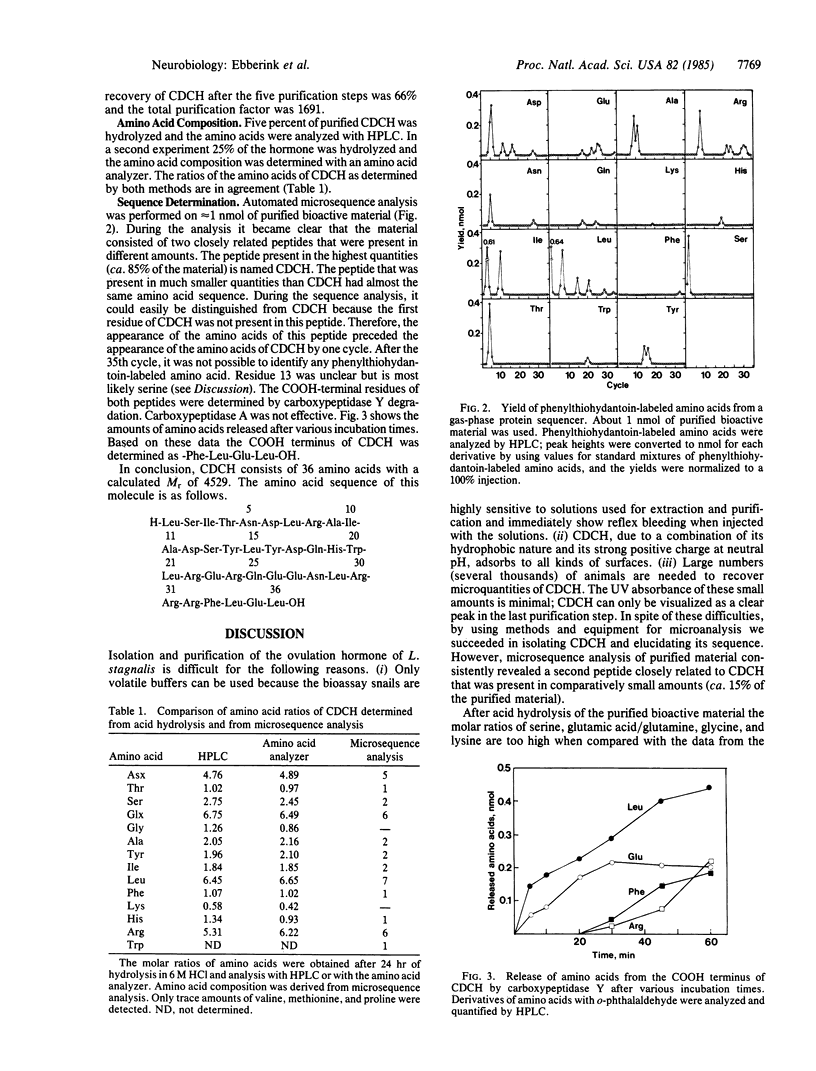
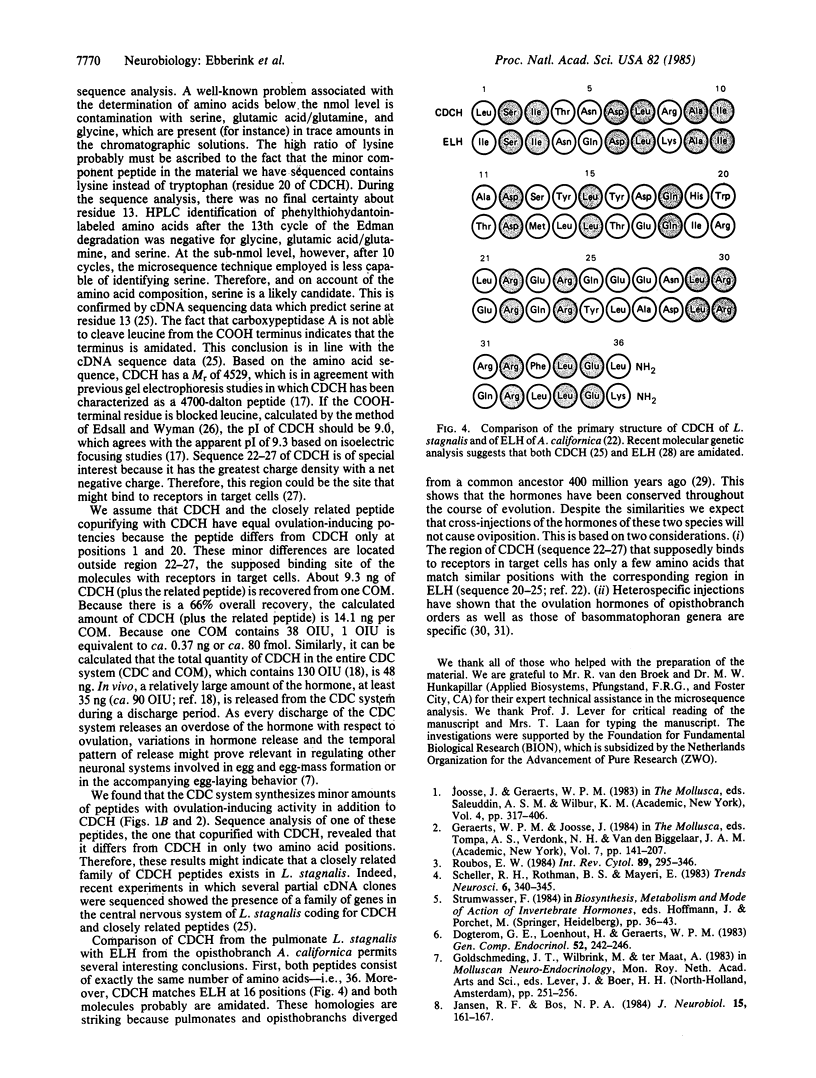
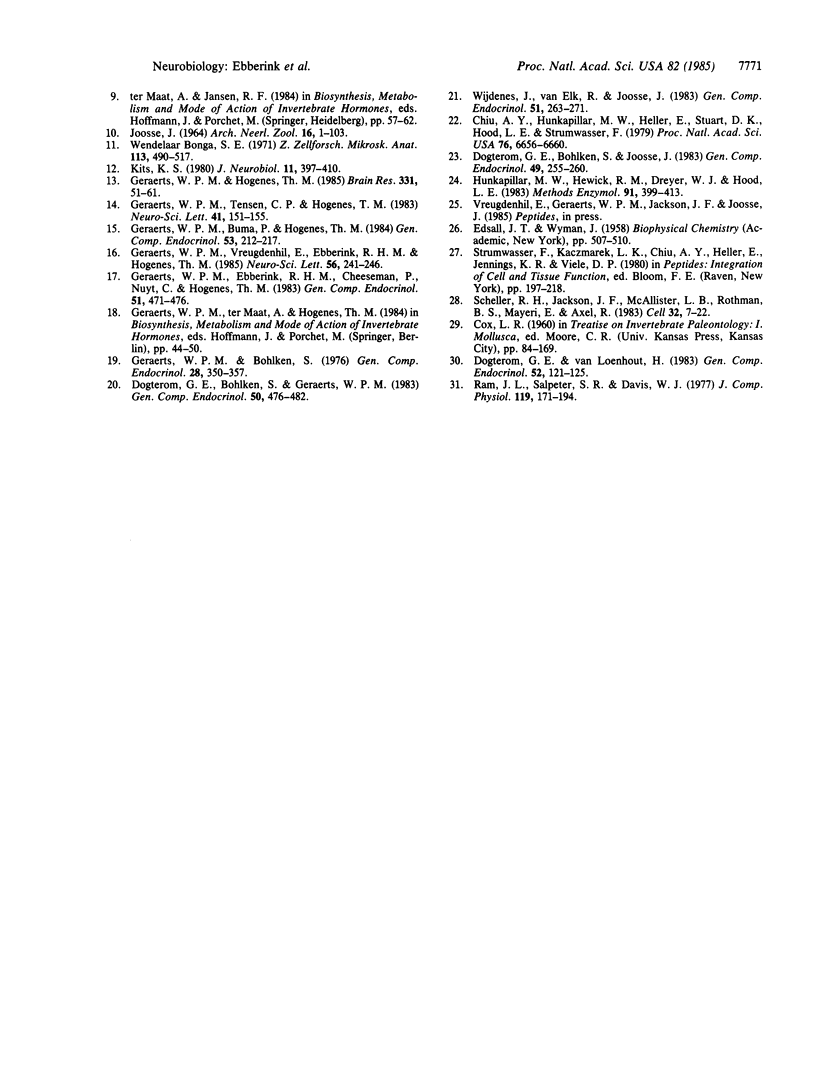
Selected References
These references are in PubMed. This may not be the complete list of references from this article.
- Bonga S. E. Formation, storage, and release of neurosecretory material studied by quantitative electron microscopy in the fresh water snail Lymnaea stagnalis (L.). Z Zellforsch Mikrosk Anat. 1971;113(4):490–517. doi: 10.1007/BF00325668. [DOI] [PubMed] [Google Scholar]
- Chiu A. Y., Hunkapiller M. W., Heller E., Stuart D. K., Hood L. E., Strumwasser F. Purification and primary structure of the neuropeptide egg-laying hormone of Aplysia californica. Proc Natl Acad Sci U S A. 1979 Dec;76(12):6656–6660. doi: 10.1073/pnas.76.12.6656. [DOI] [PMC free article] [PubMed] [Google Scholar]
- Dogterom G. E., Bohlken S., Geraerts W. P. A rapid in vivo bioassay of the ovulation hormone of Lymnaea stagnalis. Gen Comp Endocrinol. 1983 Jun;50(3):476–482. doi: 10.1016/0016-6480(83)90269-1. [DOI] [PubMed] [Google Scholar]
- Dogterom G. E., Bohlken S., Joosse J. Effect of the photoperiod on the time schedule of egg mass production in Lymnaea stagnalis, as induced by ovulation hormone injections. Gen Comp Endocrinol. 1983 Feb;49(2):255–260. doi: 10.1016/0016-6480(83)90142-9. [DOI] [PubMed] [Google Scholar]
- Dogterom G. E., van Loenhout H., Geraerts W. P. Synchronous maturation of the female reproductive system and of the ovulation hormone-producing system in Lymnaea stagnalis. Gen Comp Endocrinol. 1983 Nov;52(2):242–246. doi: 10.1016/0016-6480(83)90118-1. [DOI] [PubMed] [Google Scholar]
- Dogterom G. E., van Loenhout H. Specificity of ovulation hormones of some basommatophoran species studied by means of iso- and heterospecific injections. Gen Comp Endocrinol. 1983 Oct;52(1):121–125. doi: 10.1016/0016-6480(83)90164-8. [DOI] [PubMed] [Google Scholar]
- Geraerts W. P., Bohlken S. The control of ovulation in the hermaphroditic freshwater snail Lymnaea stagnalis by the neurohormone of the caudodorsal cells. Gen Comp Endocrinol. 1976 Mar;28(3):350–357. doi: 10.1016/0016-6480(76)90187-8. [DOI] [PubMed] [Google Scholar]
- Geraerts W. P., Buma P., Hogenes T. M. Isolation of neurosecretory granules from the neurohaemal areas of peptidergic systems of Lymnaea stagnalis, with special reference to the ovulation hormone-producing caudodorsal cells. Gen Comp Endocrinol. 1984 Feb;53(2):212–217. doi: 10.1016/0016-6480(84)90244-2. [DOI] [PubMed] [Google Scholar]
- Geraerts W. P., Cheeseman P., Ebberink R. H., Nuyt K., Hogenes T. M. Partial purification and characterization of the ovulation hormone of the freshwater pulmonate snail Lymnaea stagnalis. Gen Comp Endocrinol. 1983 Sep;51(3):471–476. doi: 10.1016/0016-6480(83)90064-3. [DOI] [PubMed] [Google Scholar]
- Geraerts W. P., Hogenes T. M. Heterogeneity of peptides released by electrically active neuroendocrine caudodorsal cells of Lymnaea stagnalis. Brain Res. 1985 Apr 1;331(1):51–61. doi: 10.1016/0006-8993(85)90714-0. [DOI] [PubMed] [Google Scholar]
- Geraerts W. P., Tensen C. P., Hogenes T. M. Multiple release of peptides by electrically active neurosecretory caudo-dorsal cells of Lymnaea stagnalis. Neurosci Lett. 1983 Oct 31;41(1-2):151–155. doi: 10.1016/0304-3940(83)90238-0. [DOI] [PubMed] [Google Scholar]
- Geraerts W. P., Vreugdenhil E., Ebberink R. H., Hogenes T. M. Synthesis of multiple peptides from a larger precursor in the neuroendocrine caudo-dorsal cells of Lymnaea stagnalis. Neurosci Lett. 1985 May 14;56(2):241–246. doi: 10.1016/0304-3940(85)90136-3. [DOI] [PubMed] [Google Scholar]
- Hunkapiller M. W., Hewick R. M., Dreyer W. J., Hood L. E. High-sensitivity sequencing with a gas-phase sequenator. Methods Enzymol. 1983;91:399–413. doi: 10.1016/s0076-6879(83)91038-8. [DOI] [PubMed] [Google Scholar]
- Jansen R. F., Bos N. P. An identified neuron modulating the activity of the ovulation hormone producing caudo-dorsal cells of the pond snail Lymnaea stagnalis. J Neurobiol. 1984 Mar;15(2):161–167. doi: 10.1002/neu.480150209. [DOI] [PubMed] [Google Scholar]
- Kits K. S. States of excitability in ovulation hormone producing neuroendocrine cells of Lymnaea stagnalis (gastropoda) and their relation to the egg-laying cycle. J Neurobiol. 1980 Jul;11(4):397–410. doi: 10.1002/neu.480110406. [DOI] [PubMed] [Google Scholar]
- Roubos E. W. Cytobiology of the ovulation-neurohormone producing neuroendocrine caudo-dorsal cells of Lymnaea stagnalis. Int Rev Cytol. 1984;89:295–346. doi: 10.1016/s0074-7696(08)61306-6. [DOI] [PubMed] [Google Scholar]
- Scheller R. H., Jackson J. F., McAllister L. B., Rothman B. S., Mayeri E., Axel R. A single gene encodes multiple neuropeptides mediating a stereotyped behavior. Cell. 1983 Jan;32(1):7–22. doi: 10.1016/0092-8674(83)90492-0. [DOI] [PubMed] [Google Scholar]
- Strumwasser F., Kaczmarek L. K., Chiu A. Y., Heller E., Jennings K. R., Viele D. P. Peptides controlling behavior in Aplysia. Soc Gen Physiol Ser. 1980;35:197–218. [PubMed] [Google Scholar]
- Wijdenes J., van Elk R., Joosse J. Effects of two gonadotropic hormones on polysaccharide synthesis in the albumen gland of Lymnaea stagnalis, studied with the organ culture technique. Gen Comp Endocrinol. 1983 Aug;51(2):263–271. doi: 10.1016/0016-6480(83)90080-1. [DOI] [PubMed] [Google Scholar]


